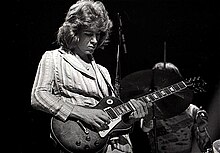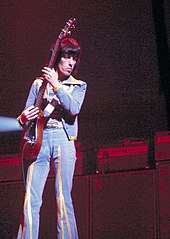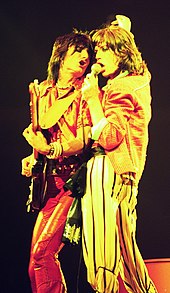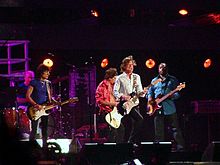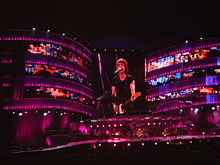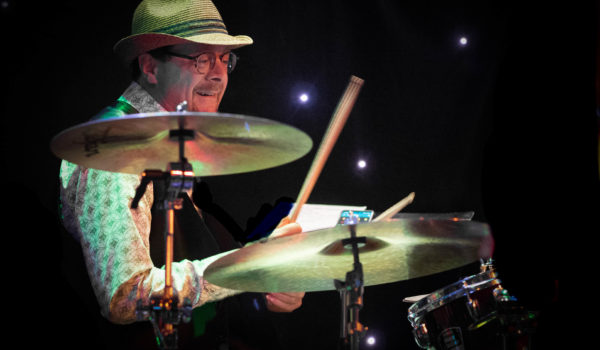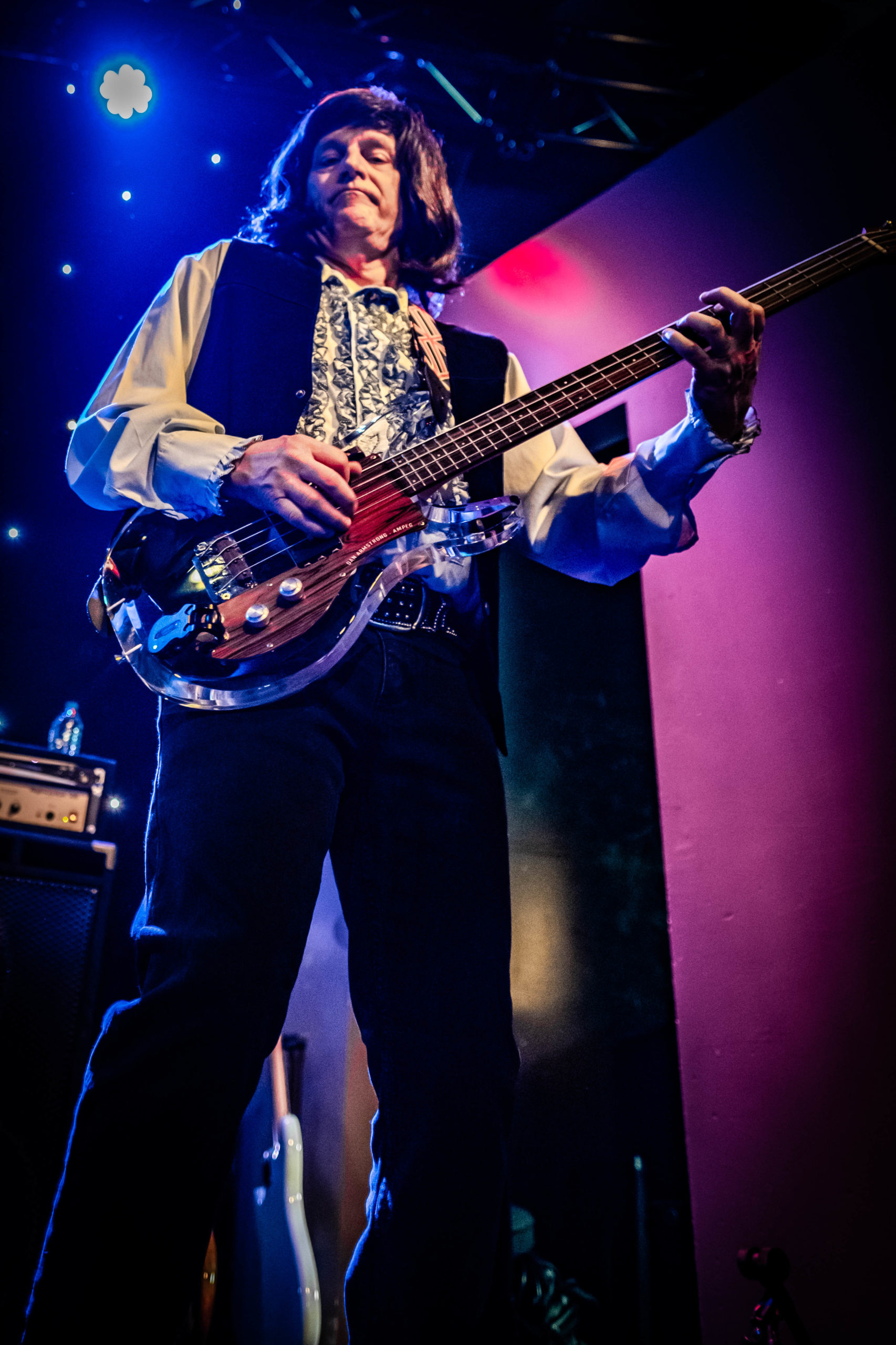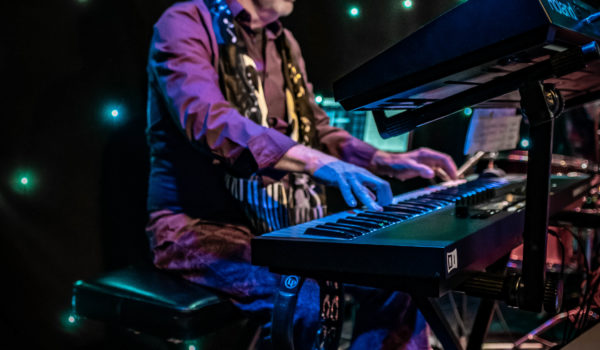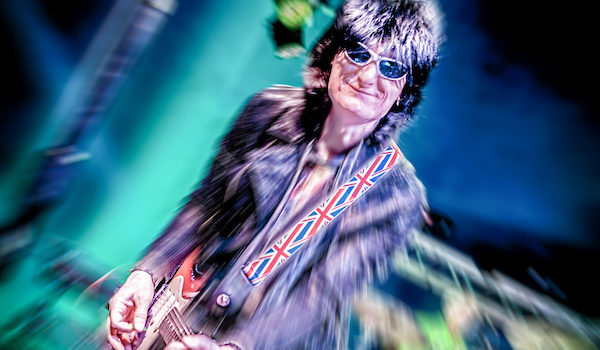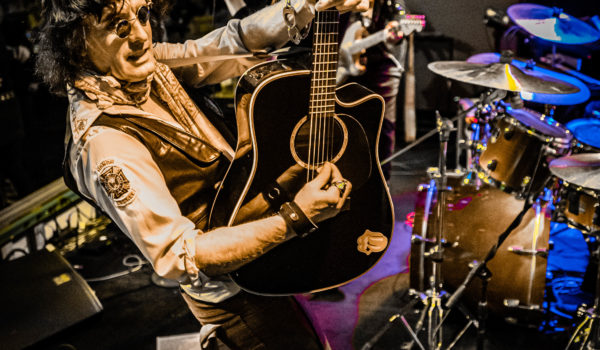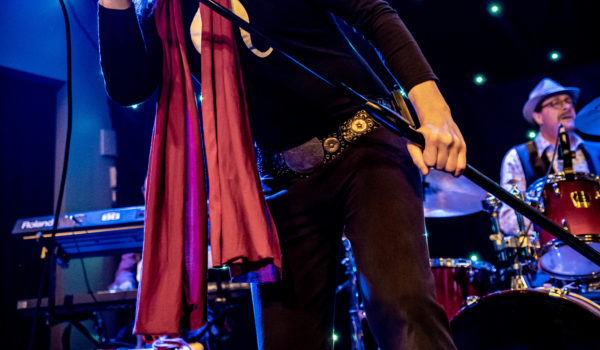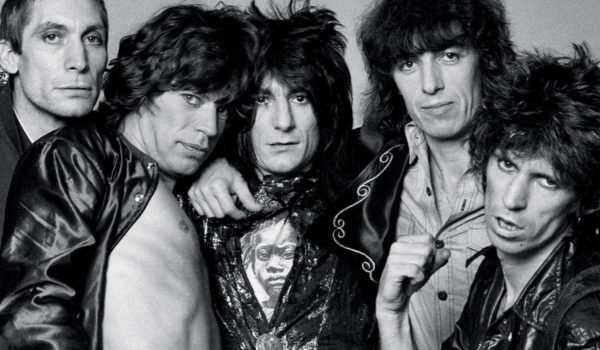The Rolling Stones
The Rolling Stones
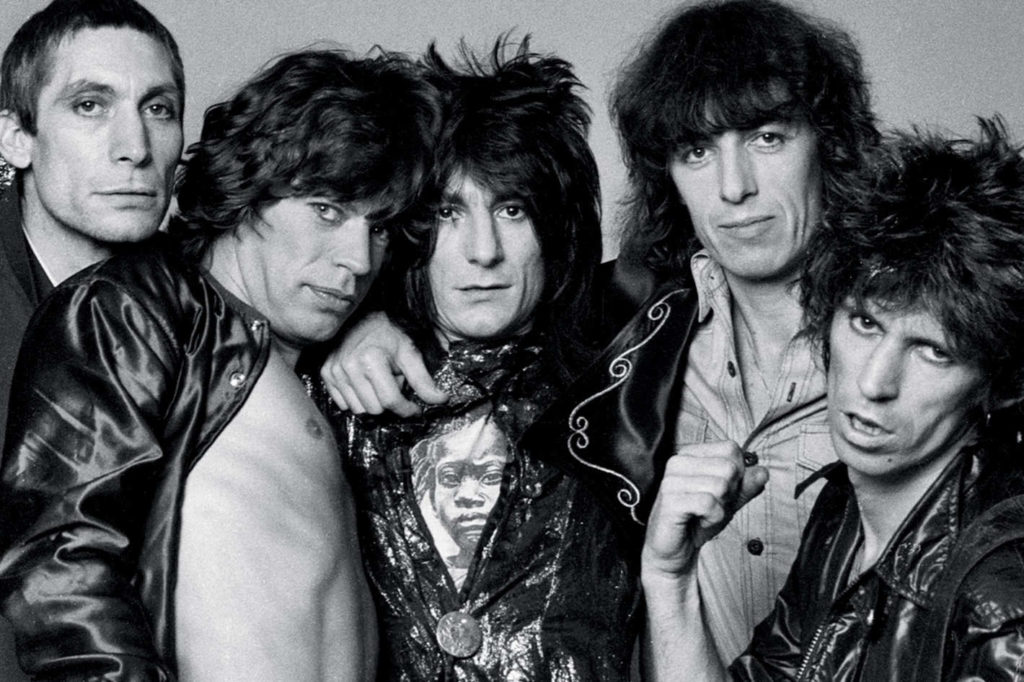
Biography
The Rolling Stones are an English rock band formed in London in 1962. The original line-up consisted of Brian Jones (rhythm guitar, harmonica), Mick Jagger (lead vocals), Keith Richards (lead guitar, backing vocals), Bill Wyman (bass), Charlie Watts (drums), and Ian Stewart (piano). Stewart was removed from the official line-up in 1963 but continued as a touring member until his death in 1985. Jones left the band less than a month prior to his death in 1969, having already been replaced by Mick Taylor, who remained until 1974. After Taylor left the band, Ronnie Wood took his place in 1975 and has been on guitar in tandem with Richards ever since. Following Wyman’s departure in 1993, Darryl Jones joined as their touring bassist. Other touring keyboardists for the band have been Nicky Hopkins (1967–82), Billy Preston (through the mid-1970s) and Chuck Leavell (1982-present). The band was first led by Jones, but after teaming as the band’s songwriters, Jagger and Richards assumed leadership while Jones dealt with legal and personal troubles.
The Rolling Stones were at the forefront of the British Invasion of bands that became popular in the US in 1964, and identified with the youthful and rebellious counterculture of the 1960s. Rooted in blues and early rock and roll, the group began a short period of musical experimentation in the mid-1960s that peaked with the psychedelic album Their Satanic Majesties Request (1967). Subsequently, the group returned to its “bluesy” roots with Beggars Banquet (1968) which along with its follow-ups Let It Bleed (1969), Sticky Fingers (1971) and Exile on Main St. (1972) is generally considered to be the band’s best work and is seen as their “Golden Age”. During this period, they were first introduced on stage as “The World’s Greatest Rock and Roll Band”.[1][2] Musicologist Robert Palmer attributed the “remarkable endurance” of the Rolling Stones to being “rooted in traditional verities, in rhythm-and-blues and soul music”, while “more ephemeral pop fashions have come and gone”.[3]
The band continued to release commercially successful records in the 1970s and sold many albums, including Some Girls (1978) and Tattoo You (1981), which were their most popular albums worldwide. From 1983 to 1987, tensions between Jagger and Richards almost caused the band to split. However, they managed to patch up their friendship in 1987. They separated temporarily to work on solo projects and experienced a comeback with Steel Wheels (1989), which was followed by a large stadium and arena tour. Since the 1990s, new recorded material from the group has been increasingly less well-received and less frequent. Despite this, the Rolling Stones have continued to be a huge attraction on the live circuit, with stadium tours in the 1990s and 2000s. By 2007, the band had four of the top five highest-grossing concert tours of all time: Voodoo Lounge Tour (1994–95), Bridges to Babylon Tour (1997–98), Licks Tour (2002–03) and A Bigger Bang Tour (2005–07).[4]
The Rolling Stones were inducted into the Rock and Roll Hall of Fame in 1989 and the UK Music Hall of Fame in 2004. Rolling Stone magazine ranked them fourth on the “100 Greatest Artists of All Time” list and their estimated album sales are above 250 million. They have released 30 studio albums, 18 live albums and numerous compilations. Let It Bleed (1969) was their first of five consecutive number one studio and live albums in the UK. Sticky Fingers (1971) was the first of eight consecutive number one studio albums in the US. In 2008, the band ranked 10th on the Billboard Hot 100 All-Time Top Artists chart. In 2012, the band celebrated its 50th anniversary.
Early history
Keith Richards and Mick Jagger were childhood friends and classmates in Dartford, Kent, until the Jaggers moved to Wilmington.[5] Jagger had formed a garage band with Dick Taylor, mainly playing Muddy Waters, Chuck Berry, Little Richard, Howlin’ Wolf and Bo Diddley material.[5] Jagger met Richards again in 1960 on platform two of Dartford railway station.[6] The Chuck Berry and Muddy Waters records that Jagger carried revealed a common interest that prompted their musical partnership.[6][7] Richards joined Jagger and Taylor at frequent meetings at Jagger’s house. The meetings switched to Taylor’s house in late 1961, where the three were joined by Alan Etherington and Bob Beckwith. They called themselves the Blue Boys.[8]
In March 1962, the Blue Boys read about the Ealing Jazz Club in the Jazz News newspaper and visited the place on 7 April 1962. The band members met Brian Jones there, as he sat in playing slide guitar with Alexis Korner‘s seminal London rhythm and blues band, Blues Incorporated, the band that also had future Rolling Stones members Ian Stewart and Charlie Watts.[9] Before visiting the Ealing Jazz Club, the Blue Boys had sent a tape of their best recordings to Alexis Korner, who was impressed.[9] After a meeting with Korner, Jagger and Richards started jamming with Blues Incorporated.[9]
Brian Jones advertised for bandmates in the Jazz News, and Ian Stewart found a practice space and joined with Jones to start a rhythm and blues band playing Chicago blues. Shortly thereafter, Jagger, Taylor and Richards left Blues Incorporated to join Jones and Stewart in their effort. Also at the first rehearsal were guitarist Geoff Bradford and vocalist Brian Knight, both of whom declined to join the band, citing objections to playing the Chuck Berry and Bo Diddley songs preferred by Jagger and Richards.[10] In June 1962 the line-up was as follows: Jagger, Jones, Richards, Stewart, Taylor, and drummer Tony Chapman. According to Richards, Jones christened the band during a phone call to Jazz News. When asked for a band name Jones saw a Muddy Waters LP lying on the floor. One of the LP’s tracks was “Rollin’ Stone“.[11][12]
1962–1964: Building a following
The back room of what was the Crawdaddy Club in Richmond, London where the Rolling Stones had their first residency in 1963
Jagger, Richards and Jones with Stewart and Dick Taylor on bass played a gig billed as “the Rollin’ Stones” on 12 July 1962, at the Marquee Club, 165 Oxford Street, London.[13] Their material included the Chicago blues as well as Chuck Berry and Bo Diddley songs.[14] Bassist Bill Wyman joined in December 1962 and drummer Charlie Watts the following January 1963 to form the band’s original rhythm section.[15][16] The Rolling Stones’ then acting manager Giorgio Gomelsky secured a Sunday afternoon residency at the Crawdaddy Club in Richmond, which, Gomelsky said, triggered an “international renaissance for the blues” and was a seminal facet of Swinging London’s advent.[17]
The Rolling Stones signed manager Andrew Loog Oldham, a publicist who was directed to the band by previous clients, the Beatles.[18] Because Oldham had not reached majority—he was nineteen and younger than any member of the band—he could not get an agent’s licence nor sign any contracts without his mother also signing.[18] By necessity he joined with booking agent Eric Easton.[19][20][21] Gomelsky had no written agreement with the band and was not consulted.[22] Initially Oldham tried to apply the “Epstein” strategy of making the band members wear suits. Later, he changed his strategy. He imagined a band which contrasted with the neat, smiling Beatles image. Oldham stated:[23] “The overall hustle I invented for the Stones was to establish them as a raunchy, gamy, unpredictable bunch of undesirables. I decided that since the Beatles had already usurped the clean-cut choirboy image with synchronized jackets, I should take the Stones down the opposite road. Rejecting matching clothing was one step, emphasizing their long hair and unclean appearance was another, and indicating the press to write about them, using catchy phrases that I had coined was yet another… I wanted to establish that the Stones were threatening, uncouth and animalistic.” Consequently, Ian Stewart left the official lineup, but stayed as road manager and touring keyboardist. Oldham explained Stewart’s decision: “Well, he just doesn’t look the part, and six is too many for [fans] to remember the faces in the picture.” Later, Oldham cut a few years off the ages of the band members to make them appear as teens.
Decca Records, which had passed on signing the Beatles, gave the Rolling Stones a recording contract with very favourable terms.[24] The band got three times a new act’s typical royalty rate, full artistic control of recordings, and ownership of the recording masters.[25][26] The deal also let the band use non-Decca recording studios. Regent Sound Studios, a mono facility equipped with egg boxes on the ceiling for sound treatment, became the preferred facility.[27][28] Oldham, who had no recording experience but made himself the band’s producer, said Regent had a sound that “leaked, instrument-to-instrument, the right way” creating a “wall of noise” that worked well for the band.[26][29] Due to Regent’s low rates, the band could record for extended periods rather than the usual three-hour blocks then prevalent at other studios. All tracks on the first Rolling Stones UK album were recorded at Regent.[30][31]
Oldham contrasted the Rolling Stones’ independence with the Beatles’ obligation to record in EMI‘s studios, saying it made them appear as “mere mortals … sweating in the studio for the man”.[32] Oldham promoted the Rolling Stones as the nasty counterpoints to the Beatles by having the band pose unsmiling on the cover of their first UK album. He also encouraged the press to use provocative headlines such as “Would you let your daughter marry a Rolling Stone?”[33] Though Oldham initially had dressed the band in uniform suits, the band drifted back to wearing everyday clothes for public appearances.[34] According to Wyman: “Our reputation and image as the Bad Boys came later, completely there, accidentally. Andrew never did engineer it. He simply exploited it exhaustively”.[35]
“we were the first pop group to break away from the whole Cliff Richard thing where the bands did little dance steps, wore identical uniforms and had snappy patter”. – Bill Wyman[36]
A cover of Chuck Berry’s “Come On” was the Rolling Stones’ first single, released on 7 June 1963. The band refused to play it at live gigs,[37] and Decca bought only one ad to promote the single. With Oldham’s direction, fan-club members bought copies at record shops polled by the charts,[38] helping “Come On” rise to No.21 on the UK singles charts.[39] Having a charting single gave the band entree to play outside London, starting with a booking at the Outlook Club in Middlesbrough on 13 July, sharing the billing with the Hollies.[40] Bill Wyman’s book Rolling With The Stones incorrectly states the band played the Alcove club that night. Later in the year Oldham and Easton arranged the band’s first big UK concert tour as a supporting act for American stars including Bo Diddley, Little Richard, and the Everly Brothers. This Autumn 1963 tour became a “training ground” for the young band’s stagecraft.[26][41][42]
During this tour the Rolling Stones recorded their second single, a Lennon–McCartney-penned number entitled “I Wanna Be Your Man“;[43] it reached No. 12 in the UK charts. Their third single, Buddy Holly‘s “Not Fade Away“, itself based on Bo Diddley’s style, was released in February 1964 and reached No. 3.[44]
Oldham saw little future for an act that lost significant songwriting royalties by playing songs of “middle-aged blacks,” limiting the appeal to teenage audiences. Jagger and Richards decided to write songs together, the first batch of which Oldham described as “soppy and imitative.”[45] Because songwriting developed slowly, songs on the band’s first album The Rolling Stones (issued in the US as England’s Newest Hit Makers,) were primarily covers, with only one Jagger/Richards original – “Tell Me (You’re Coming Back)” – and two numbers credited to Nanker Phelge, the pen name for songs written by the entire group.[46]
The Rolling Stones’ first US tour in June 1964 was, in Bill Wyman’s words, “a disaster.” “When we arrived, we didn’t have a hit record [there] or anything going for us.”[47] When the band appeared on the variety show The Hollywood Palace, that week’s guest host Dean Martin mocked both their hair and their performance.[48] During the tour they recorded for two days at Chess Studios in Chicago, meeting many of their most important influences, including Muddy Waters.[49][50] These sessions included what would become the Rolling Stones’ first number 1 hit in the UK: their cover of Bobby and Shirley Womack‘s “It’s All Over Now“.[51]
“The Stones” followed James Brown & the Famous Flames in the filmed theatrical release of The TAMI Show, which showcased American acts with British Invasion artists. According to Jagger in 2003, “We weren’t actually following James Brown because there was considerable time between the filming of each section. Nevertheless, he was still very annoyed about it …”[52] On 25 October, the band also appeared on The Ed Sullivan Show. Because of the initial pandemonium the Rolling Stones caused, Sullivan banned the band from his show,[53] though he booked for subsequent appearances in the years following.[54] Their second LP – the US-only 12 X 5 – was released during this tour.[55]
The Rolling Stones’ fifth UK single, a cover of Willie Dixon‘s “Little Red Rooster” – backed by “Off the Hook” credited to Nanker Phelge – was released in November 1964 and became their second No.1 hit in the UK, an unprecedented achievement for a blues number.[44] The band’s US distributors (London Records) declined to release “Little Red Rooster” as a single. In December 1964, London Records released the band’s first single with Jagger/Richards originals on both sides: “Heart of Stone“, backed with “What a Shame”; “Heart of Stone” went to number 19 in the US.[56]
1965–1967: Height of fame
The band’s second UK LP – The Rolling Stones No. 2, released in January 1965, charted at number 1 as an album, and the US version, released in February as The Rolling Stones, Now!, reached number 5. The album was recorded at Chess Studios in Chicago and RCA Studios in Los Angeles.[57] In January/February 1965 the band played 34 shows for about 100,000 people in Australia and New Zealand.[58]
The first Jagger/Richards composition to reach number 1 on the UK singles charts was “The Last Time” (released in February 1965).[44] it went to number 9 in the US. It was also later identified by Richards as “the bridge into thinking about writing for the Stones. It gave us a level of confidence; a pathway of how to do it.”[59]
Their first international number 1 hit was “(I Can’t Get No) Satisfaction“, recorded in May 1965 during the band’s third North American tour. In recording the guitar riff with the fuzzbox that drives the song, Richards had envisioned it as a scratch track to guide a horn section. In spite of this, the final cut was without the planned horn overdubs. Issued in the summer of 1965, it was their fourth UK No. 1 and first US No. 1 where it spent four weeks at the top of the Billboard Hot 100, establishing the Rolling Stones as a worldwide premier act.[59][60]
The US version of the LP Out of Our Heads (released in July 1965) also went to number 1; it included seven original songs (three Jagger/Richards numbers and four credited to Nanker Phelge).[61] Their second international number-1 single, “Get Off of My Cloud” was released in the autumn of 1965,[54] followed by another US-only LP: December’s Children.[55]
Aftermath (UK number 1; US 2), released in the late spring of 1966, was the first Rolling Stones album to be composed entirely of Jagger/Richards songs. On this album Jones’ contributions expanded beyond guitar and harmonica. To the Middle Eastern-influenced “Paint It, Black” he added sitar, to the ballad “Lady Jane” he added dulcimer, and to “Under My Thumb” he added marimbas. Aftermath was also notable for the almost 12-minute-long “Goin’ Home“.
The Stones’ success on the British and American singles charts peaked during 1966. “19th Nervous Breakdown“[62] (Feb. 1966, UK number 2, US number 2) was followed by their trans-Atlantic number-1 hit “Paint It, Black” (May 1966).[44] “Mother’s Little Helper” (June 1966) reached number 8 in the US; it was one of the first pop songs to address the issue of prescription drug abuse.
The September 1966 single “Have You Seen Your Mother, Baby, Standing In The Shadow?” (UK number 5, US number 9) was notable in several respects: It was the first Stones recording to feature brass horns, the (now-famous) back-cover photo on the original US picture sleeve depicted the group satirically dressed in drag, and the song was accompanied by one of the first official music videos, directed by Peter Whitehead.[63][64]
In early 1967, Jagger, Richards and Jones began to be hounded by authorities over their recreational drug use, after News of the World ran a three-part feature entitled “Pop Stars and Drugs: Facts That Will Shock You”. The series described alleged LSD parties hosted by the Moody Blues and attended by top stars including the Who‘s Pete Townshend and Cream‘s Ginger Baker, and alleged admissions of drug use by leading pop musicians. The first article targeted Donovan (who was raided and charged soon after); the second instalment (published on 5 February) targeted the Rolling Stones.[68]January 1967 saw the release of Between the Buttons (UK number 3; US 2); the album was Andrew Oldham’s last venture as the Rolling Stones’ producer (his role as the band’s manager had been taken over by Allen Klein in 1965). The US version included the double A-side single “Let’s Spend the Night Together” and “Ruby Tuesday“,[65] which went to number 1 in the US and number 3 in the UK. When the band went to New York to perform the numbers on The Ed Sullivan Show, they were ordered to change the lyrics of the refrain to “let’s spend some time together”.[66][67]
A reporter who contributed to the story spent an evening at the exclusive London club Blaise’s, where a member of the Rolling Stones allegedly took several Benzedrine tablets, displayed a piece of hashish and invited his companions back to his flat for a “smoke”. The article claimed that this was Mick Jagger, but it turned out to be a case of mistaken identity—the reporter had in fact been eavesdropping on Brian Jones. On the night the article was published Jagger appeared on the Eamonn Andrews chat show and announced that he was filing a writ for libel against the paper.[68]
A week later on 12 February, Sussex police, tipped off by the News of the World, who in turn were tipped off by Richards’ chauffeur,[69] raided a party at Keith Richards’ home, Redlands. No arrests were made at the time but Jagger, Richards and their friend art dealer Robert Fraser were subsequently charged with drug offenses. Richards said in 2003, “When we got busted at Redlands, it suddenly made us realize that this was a whole different ball game and that was when the fun stopped. Up until then it had been as though London existed in a beautiful space where you could do anything you wanted.”[70] On the treatment of the man responsible for the raid he later added: “As I heard it, he never walked the same again.”[69]
In March 1967, while awaiting the consequences of the police raid, Jagger, Richards and Jones took a short trip to Morocco, accompanied by Marianne Faithfull, Jones’ girlfriend Anita Pallenberg and other friends. During this trip the stormy relations between Jones and Pallenberg deteriorated to the point that Pallenberg left Morocco with Richards.[71] Richards said later: “That was the final nail in the coffin with me and Brian. He’d never forgive me for that and I don’t blame him, but hell, shit happens.”[72] Richards and Pallenberg would remain a couple for twelve years. Despite these complications, the Rolling Stones toured Europe in March and April 1967. The tour included the band’s first performances in Poland, Greece, and Italy.[73]
On 10 May 1967, the same day Jagger, Richards and Fraser were arraigned in connection with the Redlands charges—Brian Jones’ house was raided by police and he was arrested and charged with possession of cannabis.[66] Three out of five Rolling Stones now faced drug charges. Jagger and Richards were tried at the end of June. On 29 June Jagger was sentenced to three months’ imprisonment for possession of four amphetamine tablets; Richards was found guilty of allowing cannabis to be smoked on his property and sentenced to one year in prison.[74][75] Both Jagger and Richards were imprisoned at that point, but were released on bail the next day pending appeal.[76] The Times ran the famous editorial entitled “Who breaks a butterfly on a wheel?” in which conservative editor William Rees-Mogg surprised his readers by his unusually critical discourse on the sentencing, pointing out that Jagger had been treated far more harshly for a minor first offense than “any purely anonymous young man”.[77]
While awaiting the appeal hearings, the band recorded a new single, “We Love You“, as a thank-you for the loyalty shown by their fans. It began with the sound of prison doors closing, and the accompanying music video included allusions to the trial of Oscar Wilde.[78] On 31 July, the appeals court overturned Richards’ conviction, and Jagger’s sentence was reduced to a conditional discharge.[79] Brian Jones’ trial took place in November 1967; in December, after appealing the original prison sentence, Jones was fined £1000, put on three years’ probation and ordered to seek professional help.[80]
December 1967 also saw the release of Their Satanic Majesties Request (UK number 3; US 2), which received unfavourable reviews and was widely regarded as a poor imitation of the Beatles’ Sgt. Pepper’s Lonely Hearts Club Band.[81][82] Satanic Majesties had been recorded in difficult circumstances while Jagger, Richards and Jones were dealing with their court cases. The band parted ways with producer Andrew Oldham during the sessions. The split was amicable, at least publicly,[83] but in 2003 Jagger said: “The reason Andrew left was because he thought that we weren’t concentrating and that we were being childish. It was not a great moment really – and I would have thought it wasn’t a great moment for Andrew either. There were a lot of distractions and you always need someone to focus you at that point, that was Andrew’s job.”[66]
Satanic Majesties thus became the first album the Rolling Stones produced on their own. Its psychedelic sound was complemented by the cover art, which featured a 3D photo by Michael Cooper, who had also photographed the cover of Sgt. Pepper. Bill Wyman wrote and sang a track on the album: “In Another Land“, which was also released as a single, the first on which Jagger did not sing lead.[84]
1968–1972: “Golden Age”
The band spent the first few months of 1968 working on material for their next album. Those sessions resulted in the song “Jumpin’ Jack Flash“, released as a single in May. The song and the subsequent album, Beggars Banquet (UK number 3; US 5), an eclectic mix of country and blues-inspired tunes, marked the band’s return to their roots, and the beginning of their collaboration with producer Jimmy Miller. It featured the lead single “Street Fighting Man” (which addressed the political upheavals of May 1968) and “Sympathy for the Devil“.[85][86]
Beggars Banquet was well received at the time of release. Richards said, “There is a change between material on Satanic Majesties and Beggars Banquet. I’d grown sick to death of the whole Maharishi guru shit and the beads and bells. Who knows where these things come from, but I guess [the music] was a reaction to what we’d done in our time off and also that severe dose of reality. A spell in prison … will certainly give you room for thought … I was fucking pissed with being busted. So it was, ‘Right we’ll go and strip this thing down.’ There’s a lot of anger in the music from that period.”[87] Richards started using open tunings for rhythm parts (often in conjunction with a capo), most prominently an open-E or open-D tuning in 1968. Beginning in 1969, he often used 5-string open-G tuning (with the lower 6th string removed), as heard on the 1969 single “Honky Tonk Women“, “Brown Sugar” (Sticky Fingers, 1971), “Tumbling Dice” (capo IV), “Happy” (capo IV) (Exile on Main St., 1972), and “Start Me Up” (Tattoo You, 1981).[88]
The end of 1968 saw the filming of The Rolling Stones Rock and Roll Circus. It featured John Lennon, Yoko Ono, the Dirty Mac, the Who, Jethro Tull, Marianne Faithfull, and Taj Mahal. The footage was shelved for twenty-eight years but was finally released officially in 1996,[89] with a DVD version released in October 2004.[90]
By the release of Beggars Banquet, Brian Jones was increasingly troubled and was only sporadically contributing to the band. Jagger said that Jones was “not psychologically suited to this way of life”.[91] His drug use had become a hindrance, and he was unable to obtain a US visa. Richards reported that, in a June meeting with Jagger, Richards, and Watts at Jones’ house, Jones admitted that he was unable to “go on the road again”, and left the band, saying “‘I’ve left, and if I want to I can come back'”.[7] On 3 July 1969, less than a month later, Jones drowned in the swimming pool under mysterious circumstances at his home, Cotchford Farm, in Hartfield, East Sussex.[92][93]
The Rolling Stones were scheduled to play at a free concert for Blackhill Enterprises in London’s Hyde Park, two days after Brian Jones’ death; they decided to proceed with the show as a tribute to Jones. The concert, their first with new guitarist Mick Taylor, was performed in front of an estimated 250,000 fans.[66] The performance was filmed by a Granada Television production team, and was shown on British television as The Stones in the Park. Jagger read an excerpt from Shelley‘s poem Adonaïs, an elegy written on the death of his friend John Keats, and they released thousands of butterflies in memory of Jones[66] before opening their set with “I’m Yours and I’m Hers”, a Johnny Winter number.[94]
Also performed, but previously unheard by the audience, were “Midnight Rambler” and “Love in Vain” from their forthcoming album Let It Bleed (released December 1969) and “Give Me A Drink” which eventually appeared on Exile on Main St. (released May 1972). The show also included the concert debut of “Honky Tonk Women“, which the band had just released the previous day. The Blackhill Enterprises stage manager Sam Cutler introduced them as “the greatest rock & roll band in the world”,[1][94] a description he repeated throughout their 1969 US tour, and which has stuck to this day (Cutler left Blackhill Enterprises to become the Stones’ road manager following the Hyde Park concert).[95][96]
Other tracks include “You Can’t Always Get What You Want” (with accompaniment by the London Bach Choir, who initially asked for their name to be removed from the album’s credits after being apparently ‘horrified’ by the content of some of its other material, but later withdrew this request), “Midnight Rambler” as well as a cover of Robert Johnson‘s “Love in Vain“. Jones and Taylor are featured on two tracks each.The release of Let It Bleed (UK number 1; US 3) came in December. Their last album of the sixties, Let It Bleed featured “Gimme Shelter“. The lead female vocalist – and famed solo – on “Gimme Shelter” is performed by singer Merry Clayton (sister of Sam Clayton, of the American rock band Little Feat).[97]
Just after the tour the band performed at the Altamont Free Concert at the Altamont Speedway, about 50 miles east of San Francisco. The biker gang Hells Angels provided security, and a fan, Meredith Hunter, was stabbed and beaten to death by the Angels after they realised that he was armed.[98] Part of the tour and the Altamont concert were documented in Albert and David Maysles‘ film Gimme Shelter. As a response to the growing popularity of bootleg recordings (in particular the still sought-after Live’r Than You’ll Ever Be), the album Get Yer Ya-Yas Out! (UK 1; US 6) was released in 1970; it was declared by critic Lester Bangs to be the best live album ever.[99]
At the end of the decade the band appeared on the BBC’s highly rated review of the sixties music scene Pop Go the Sixties, performing “Gimme Shelter” on the show, which was broadcast live on 31 December 1969. In 1970 the band’s contracts with both Allen Klein and Decca Records ended (cf. “Schoolboy Blues“), and amid contractual disputes with Klein, they formed their own record company, Rolling Stones Records. Sticky Fingers (UK number 1; US 1), released in March 1971, the band’s first album on their own label, featured an elaborate cover design by Andy Warhol.[100] The Stones’ Decca catalogue is currently owned by Klein’s ABKCO label.
The Rolling Stones’ logo, designed by John Pasche and modified by Craig Braun,[101] was introduced in 1971.
Sticky Fingers was the first to feature the logo of Rolling Stones Records, which effectively became the band’s logo. It consisted of a pair of lips with a lapping tongue. Designer John Pasche created the logo following a suggestion by Jagger to copy the outstuck tongue of the Hindu goddess Kali.[101] Critic Sean Egan has said of the logo, “Without using the Stones’ name, it instantly conjures them, or at least Jagger, as well as a certain lasciviousness that is the Stones’ own … It quickly and deservedly became the most famous logo in the history of popular music.”[102] The tongue and lips design was part of a package that, in 2003, VH1 named the “No. 1 Greatest Album Cover” of all time.[100]
The album contains one of their best known hits, “Brown Sugar“, and the country-influenced “Dead Flowers“. Both were recorded at Alabama‘s Muscle Shoals Sound Studio during the 1969 American tour. The album continued the band’s immersion into heavily blues-influenced compositions. The album is noted for its “loose, ramshackle ambience”[103] and marked Mick Taylor’s first full release with the band.[104][105]
Following the release of Sticky Fingers, the Rolling Stones left England after receiving financial advice. They moved to the South of France, where Richards rented the Villa Nellcôte and sublet rooms to band members and entourage. Using the Rolling Stones Mobile Studio, they held recording sessions in the basement; they completed the resulting tracks, along with material dating as far back as 1969, at Sunset Studios in Los Angeles. The resulting double album, Exile on Main St. (UK number 1; US 1), was released in May 1972. Given an A+ grade by critic Robert Christgau[106] and disparaged by Lester Bangs – who reversed his opinion within months – Exile is now accepted as one of the Stones’ best albums.[107] The films Cocksucker Blues (never officially released) and Ladies and Gentlemen: The Rolling Stones (released in 1974) document the subsequent highly publicised 1972 North American (“STP”) Tour.[108]
The band’s double compilation, Hot Rocks 1964–1971 (US No.4), was released in 1972. The compilation is certified Diamond in the US having sold over 12 million copies, and has spent over 264 weeks on the Billboard album chart.[109]
1972–1977: Mid ’70s
According to a 2006 article in the Daily Mail, members of the band set up a complex financial structure in 1972 to avoid payment of taxes. Their holding company, Promogroup, has offices in both Holland and the Caribbean. Holland was selected because it does not have a direct tax on royalties. The article also says that “they have been tax exiles ever since – meaning they cannot make Britain their main home” and that “The Rolling Stones have paid just 1.6% tax on their earnings of £242 million over the past 20 years.”[110]
In November 1972, the band began sessions in Kingston, Jamaica, for their follow-up to Exile, Goats Head Soup (UK 1; US 1) (1973). The album spawned the worldwide hit “Angie“, but proved the first in a string of commercially successful but tepidly received studio albums.[111] The sessions for Goats Head Soup led to a number of outtakes, most notably an early version of the popular ballad “Waiting on a Friend“, not released until Tattoo You eight years later.[112]
The making of the record was interrupted by another legal battle over drugs, dating back to their stay in France; a warrant for Richards’ arrest had been issued, and the other band members had to return briefly to France for questioning.[113] This, along with Jagger’s convictions on drug charges (in 1967 and 1970[114]), complicated the band’s plans for their Pacific tour in early 1973: they were denied permission to play in Japan and almost banned from Australia. This was followed by a European tour (bypassing France) in September/October 1973 – prior to which Richards had been arrested once more on drug charges, this time in England.[115]
The band went to Musicland studios in Munich to record their next album, 1974’s It’s Only Rock ‘n’ Roll (UK 2; US 1), but Jimmy Miller, who had drug abuse issues, was no longer producer. Instead, Jagger and Richards assumed production duties and were credited as “the Glimmer Twins”. Both the album and the single of the same name were hits.[116][117]
Near the end of 1974, Taylor began to lose patience.[118] The band’s situation made normal functioning complicated, with band members living in different countries, and legal barriers restricting where they could tour. In addition, drug use was starting to affect Richards’ productivity, and Taylor felt some of his own creative contributions were going unrecognized.[119]At the end of 1974, with a recording session already booked in Munich to record another album, Taylor quit the Rolling Stones.[120]
Taylor said in 1980, “I was getting a bit fed up. I wanted to broaden my scope as a guitarist and do something else … I wasn’t really composing songs or writing at that time. I was just beginning to write, and that influenced my decision … There are some people who can just ride along from crest to crest; they can ride along somebody else’s success. And there are some people for whom that’s not enough. It really wasn’t enough for me.”[121]
The Rolling Stones needed to find a new guitarist, and the recording sessions for the next album, Black and Blue (UK 2; US 1) (1976) in Munich provided an opportunity for some hopefuls to work while trying out for the band. Guitarists as stylistically disparate as Peter Frampton and Jeff Beck were auditioned as well as Robert Johnson and Shuggie Otis. Both Beck and Irish blues rock guitarist Rory Gallagher later claimed that they had played without realizing they were being auditioned, and both agreed that they would never have joined. American session players Wayne Perkins and Harvey Mandel also tried out but Richards and Jagger had a preference for the band to remain purely British. When Ronnie Wood auditioned, everyone agreed that he was the right choice.[122]
Wood had already recorded and played live with Richards, and had contributed to the recording and writing of the track “It’s Only Rock ‘n Roll”. He had earlier declined Jagger’s offer to join the Stones, because of his commitment to the Faces, saying “that’s what’s really important to me”.[123] Rod Stewart went so far as to say he would take bets that Ronnie would not join the Stones.[123]
Wood officially joined the Rolling Stones in 1975 for their upcoming Tour of the Americas as the Faces dissolved. Unlike the other band members, however, Wood was paid an employee’s salary, and remained so until the early 1990s, when he finally joined the Rolling Stones’ business partnership.[124]
The 1975 Tour of the Americas kicked off in New York City with the band performing on a flatbed trailer being pulled down Broadway. The tour featured stage props including a giant phallus and a rope on which Jagger swung out over the audience. Jagger had booked live recording sessions at the El Mocambo club in Toronto to balance a long-overdue live album, 1977’s Love You Live (UK 3; US 5), the first Stones live album since 1970’s Get Yer Ya-Ya’s Out! The Rolling Stones in Concert.[125]
Richards’ addiction to heroin delayed his arrival in Toronto; the other members had already assembled, awaiting Richards, and sent him a telegram asking him where he was. On 24 February 1977, when Richards and his family flew in from London, they were temporarily detained by Canada Customs after Richards was found in possession of a burnt spoon and hash residue. Three days later, the Royal Canadian Mounted Police, armed with an arrest warrant for Pallenberg, discovered “22 grams of heroin”[126] in Richards’ room. Richards was charged with importing narcotics into Canada, an offense that carried a minimum seven-year sentence.[127]
Later the Crown prosecutor conceded that Richards had procured the drugs after arrival.[128] Despite the incident, the band played two shows in Toronto, only to raise more controversy when Margaret Trudeau, then-wife of Canadian Prime Minister Pierre Trudeau, was seen partying with the band after one show. The band’s two shows were not advertised to the public. Instead, the El Mocambo had been booked for the entire week by April Wine for a recording session. 1050 CHUM, a local radio station, ran a contest for free tickets to see April Wine. Contest winners who selected tickets for Friday or Saturday night were surprised to find the Rolling Stones playing.[129]
On 4 March, Richards’ partner Anita Pallenberg pleaded guilty to drug possession and incurred a fine in connection with the original airport incident.[129] The drug case against Richards dragged on for over a year. Ultimately, Richards received a suspended sentence and was ordered to play two free concerts for the CNIB in Oshawa;[128] both shows featured the Rolling Stones and the New Barbarians, a group that Wood had put together to promote his latest solo album, and which Richards also joined. This episode strengthened Richards’ resolve to stop using heroin.[66] It also ended his relationship with Pallenberg, which had become strained since the death of their third child (an infant son named Tara). In addition, Pallenberg was unable to curb her heroin addiction while Keith struggled to get clean.[130] While Richards was settling his legal and personal problems, Jagger continued his jet-set lifestyle. He was a regular at New York’s Studio 54 disco club, often in the company of model Jerry Hall. His marriage to Bianca Jagger ended in 1977, although they had long been estranged.[131]
Although the Rolling Stones remained popular through the early 1970s, music critics had begun to grow dismissive of the band’s output, and record sales failed to meet expectations.[54] By the mid-1970s, after punk rock became influential, many people had begun to view the Rolling Stones as an outdated band.
1978–1982: Commercial peak
This changed in 1978, after the band released Some Girls (UK No. 2; US No. 1), which included the hit single “Miss You“, the country ballad “Far Away Eyes“, “Beast of Burden“, and “Shattered“. In part as a response to punk, many songs, particularly “Respectable“, were fast, basic, guitar-driven rock and roll,[132] and the album’s success re-established the Rolling Stones’ immense popularity among young people. Following the US Tour 1978, the band guested on the first show of the fourth season of the TV series Saturday Night Live. The group did not tour Europe the following year, breaking the routine of touring Europe every three years that the band had followed since 1967.
Following the success of Some Girls, the band released their next album Emotional Rescue (UK 1; US 1) in mid-1980.[133] During the recording sessions of the album, a rift between Jagger and Richards was slowly beginning to form. Richards wanted to tour in summer or autumn of 1980 to promote the new album. Much to his disappointment, Jagger declined.[133] Emotional Rescue hit the top of the charts on both sides of the Atlantic and the title track reached No.3 in the US.[133]
In early 1981, the group reconvened and decided to tour the US that year, leaving little time to write and record a new album, as well as rehearse for the tour. That year’s resulting album, Tattoo You (UK 2; US 1), featured a number of outtakes, including lead single “Start Me Up“, which reached No.2 in the US and ranked No.22 on Billboard’s Hot 100 year-end chart. Two songs (“Waiting on a Friend” (US No. 13) and “Tops”) featured Mick Taylor’s unused rhythm guitar tracks, while jazz saxophonist Sonny Rollins played on “Slave” and “Waiting on a Friend”.[134]
The Rolling Stones scored one more top 20 hit on the Billboard Hot 100 in 1982, the No.20 hit “Hang Fire“. The Stones’ American Tour 1981 was their biggest, longest and most colorful production to date, with the band playing from 25 September through 19 December. It was the highest grossing tour of that year.[135]
Some shows were recorded, resulting in the 1982 live album Still Life (American Concert 1981) (UK 4; US 5), and the 1983 Hal Ashby concert film Let’s Spend the Night Together, which was filmed at Sun Devil Stadium in Tempe, Arizona and the Brendan Byrne Arena in the Meadowlands, New Jersey. Also in 1981, they played a concert at Chicago’s Checkerboard Lounge with Muddy Waters, in what would be one of his last performances before his death in 1983.[136]
In mid-1982, to commemorate their 20th anniversary, the Rolling Stones took their American stage show to Europe. The European Tour 1982 was their first European tour in six years. The tour was similar to their 1981 American tour. For the tour, the band were joined by former Allman Brothers Band keyboardist Chuck Leavell, who continues to perform and record with the Rolling Stones to date.[137] By the end of the year, the band had signed a new four-album recording deal with a new label, CBS Records, for a reported $50 million, then the biggest record deal in history.[138]
1983–1988: Band turmoil and solo efforts
Before leaving Atlantic, the Rolling Stones released Undercover (UK 3; US 4) in late 1983. Despite good reviews and the Top Ten peak position of the title track, the record sold below expectations and there was no tour to support it. Subsequently, the Stones’ new marketer/distributor CBS Records took over distributing the Stones’ Atlantic catalogue.[138]
By this time, the Jagger/Richards rift had grown significantly. Much to the consternation of Richards, Jagger had signed a solo deal with CBS Records, and he spent much of 1984 writing songs for his first solo. He also declared his growing lack of interest in the Rolling Stones.[139] By 1985, Jagger was spending more time on solo recordings, and much of the material on 1986’s Dirty Work was generated by Keith Richards, with more contributions by Ronnie Wood than on previous Rolling Stones albums. The album was recorded in Paris, and Jagger was often absent from the studio, leaving Richards to keep the recording sessions moving forward.[140]
In June 1985, Jagger teamed up with David Bowie for “Dancing in the Street“, which was recorded as part of the Live Aid charity movement.[141] This was one of Jagger’s first solo performances, and the song reached No 1 in the UK, and No 7 in the US.[142][143] In December 1985, the band’s co-founder, pianist, road manager and long-time friend Ian Stewart died of a heart attack. The Rolling Stones played a private tribute concert for him at London’s 100 Club in February 1986, two days before they were presented with a Grammy Lifetime Achievement Award.[144]
Dirty Work (UK No. 4; US No. 4) was released in March 1986 to mixed reviews despite the presence of the US Top Five hit “Harlem Shuffle“. With relations between Richards and Jagger at an all-time low, Jagger refused to tour to promote the album, and instead undertook his own solo tour, which included Rolling Stones songs.[145][146] Richards has referred to this period in his relations with Jagger as “World War III”.[147] As a result of the animosity within the band during this period, they almost broke up.[145] Jagger’s solo records, She’s the Boss (UK 6; US 13) (1985) and Primitive Cool (UK 26; US 41) (1987), met with moderate success, and in 1988, with the Rolling Stones mostly inactive, Richards released his first solo album, Talk Is Cheap (UK 37; US 24). It was well received by fans and critics, going gold in the US.[148]
1989–1999: Comeback, return to popularity, and record-breaking tours
In early 1989, the Rolling Stones, including Mick Taylor and Ronnie Wood as well as Brian Jones and Ian Stewart (posthumously), were inducted into the American Rock and Roll Hall of Fame.[54] Jagger and Richards set aside animosities and went to work on a new Rolling Stones album that would be called Steel Wheels (UK 2; US 3). Heralded as a return to form, it included the singles “Mixed Emotions” (US No. 5), “Rock and a Hard Place” (US No. 23) and “Almost Hear You Sigh“. The album also included “Continental Drift”, which the Rolling Stones recorded in Tangier, Morocco in 1989 with the Master Musicians of Jajouka led by Bachir Attar, coordinated by Tony King and Cherie Nutting. A BBC documentary film, The Rolling Stones in Morocco, was produced by Nigel Finch.[149]
The subsequent Steel Wheels/Urban Jungle Tours, encompassing North America, Japan, and Europe, saw the Rolling Stones touring for the first time in seven years (since Europe 1982), and it was their biggest stage production to date. Opening acts included Living Colour and Guns N’ Roses; the onstage personnel included a horn section and backup singers Lisa Fischer and Bernard Fowler, both of whom continue to tour regularly with the Rolling Stones. Recordings from the Steel Wheels/Urban Jungle tours produced the 1991 concert album Flashpoint (UK 6; US 16), which also included two studio tracks recorded in 1991: the single “Highwire” and “Sex Drive”. The tour produced the IMAX concert film Live at the Max released in 1991.[150]
These were the last Rolling Stones tours for Bill Wyman, who left the band after years of deliberation, although his retirement was not made official until January 1993.[151] He then published Stone Alone, an autobiography based on scrapbooks and diaries he had been keeping since the band’s early days. A few years later he formed Bill Wyman’s Rhythm Kings and began recording and touring again.[152]
After the successes of the Steel Wheels/Urban Jungle tours, the band took a break. Charlie Watts released two jazz albums; Ronnie Wood recorded his fifth solo album, the first in 11 years, called Slide On This; Bill Wyman released his fourth solo album; Keith Richards released his second solo album in late 1992, Main Offender, and did a small tour including big concerts in Spain and Argentina. Mick Jagger got good reviews and sales with his third solo album, Wandering Spirit (UK 12; US 11). The album sold more than two million copies worldwide, going gold in the US.[148]
Multiple platinum award for their 1994 album Voodoo Lounge, on display at the Museo del Rock in Madrid.
After Wyman’s departure, the Rolling Stones’ new distributor/record label, Virgin Records, remastered and repackaged the band’s back catalogue from Sticky Fingers to Steel Wheels, except for the three live albums, and issued another hits compilation in 1993 entitled Jump Back. By 1993 the Rolling Stones set upon their next studio album. Darryl Jones, former sideman of Miles Davis and Sting, was chosen by Charlie Watts as Wyman’s replacement for 1994’s Voodoo Lounge (UK 1; US 2). The album met strong reviews and sales, going double platinum in the US. Reviewers took note of the album’s “traditionalist” sounds, which were credited to the Rolling Stones’ new producer Don Was.[153] Voodoo Lounge would win the Stones the Grammy Award for Best Rock Album at the 1995 Grammy Awards.[154]
1994 also brought the accompanying Voodoo Lounge Tour, which lasted into 1995. The tour grossed $320 million, becoming the world’s highest grossing tour at the time.[155]Numbers from various concerts and rehearsals (mostly acoustic) made up Stripped (UK 9; US 9), which featured a cover of Bob Dylan’s “Like a Rolling Stone“, as well as infrequently played songs like “Shine a Light“, “Sweet Virginia” and “The Spider and the Fly“.[156] On 8 September 1994, the Rolling Stones performed their new song “Love Is Strong” as well as “Start Me Up” at the 1994 MTV Video Music Awards at Radio City Music Hall in New York.[157] The band received the Lifetime Achievement Award at the ceremony.[157]
The Rolling Stones were the first major recording artists to broadcast a concert over the Internet; a 20-minute video was broadcast on 18 November 1994 using the Mbone at 10 frames per second. The broadcast, engineered by Thinking Pictures and financed by Sun Microsystems, was one of the first demonstrations of streaming video; while it was not a true webcast, it introduced many to the technology.[158]
The Rolling Stones ended the 1990s with the album Bridges to Babylon (UK 6; US 3), released in 1997 to mixed reviews. The video of the single “Anybody Seen My Baby?” featured Angelina Jolie as guest and met steady rotation on both MTV and VH1. Sales were reasonably equivalent to those of previous records (about 1.2 million copies sold in the US), and the subsequent Bridges to Babylon Tour, which crossed Europe, North America and other destinations, proved the band to be a strong live attraction. Once again, a live album was culled from the tour, No Security (UK 67; US 34), only this time all but two songs (“Live With Me” and “The Last Time”) were previously unreleased on live albums. In 1999, the Rolling Stones staged the No Security Tour in the US and continued the Bridges to Babylon tour in Europe.
2000–2011: A Bigger Bang and continued success
In late 2001, Mick Jagger released his fourth solo album, Goddess in the Doorway (UK 44; US 39) which met with mixed reviews.[159] A month after the September 11 attacks, Jagger and Richards took part in “The Concert for New York City“, performing “Salt of the Earth” and “Miss You” with a backing band.[160]
In 2002, the band released Forty Licks (UK 2; US 2), a greatest hits double album, to mark their forty years as a band. The collection contained four new songs recorded with the latter-day core band of Jagger, Richards, Watts, Wood, Leavell and Jones. The album has sold more than 7 million copies worldwide. The same year, Q magazine named the Rolling Stones as one of the “50 Bands To See Before You Die”,[161] and the 2002–2003 Licks Tour gave people that chance. The tour included shows in small theatres. The band headlined the Molson Canadian Rocks for Toronto concert in Toronto, Ontario, Canada, to help the city – which they have used for rehearsals since the Steel Wheels tour – recover from the 2003 SARS epidemic. The concert was attended by an estimated 490,000 people.[162]
On 9 November 2003, the band played their first concert in Hong Kong as part of the Harbour Fest celebration, also in support of the SARS-affected economy. In November 2003, the band exclusively licensed the right to sell their new four-DVD boxed set, Four Flicks, recorded on the band’s most recent world tour, to the US Best Buy chain of stores. In response, some Canadian and US music retail chains (including HMV Canada and Circuit City) pulled Rolling Stones CDs and related merchandise from their shelves and replaced them with signs explaining the situation.[163] In 2004, a double live album of the Licks Tour, Live Licks (UK 38; US 50), was released, going gold in the US.[148] In November 2004, the Rolling Stones were among the inaugural inductees into the UK Music Hall of Fame.[164]
On 26 July 2005, Jagger’s birthday, the band announced the name of their new album, A Bigger Bang (UK 2; US 3), their first album in almost eight years. A Bigger Bang was released on 6 September to strong reviews, including a glowing write-up in Rolling Stone magazine.[165] The single “Streets of Love” reached the top 15 in the UK.[166]
The album included the political “Sweet Neo Con“, a criticism of American Neoconservatism from Jagger.[167] The song was reportedly almost dropped from the album because of objections from Richards. When asked if he was afraid of political backlash such as the Dixie Chicks had endured, Richards responded that the album came first, and that, “I don’t want to be sidetracked by some little political ‘storm in a teacup’.”[168]
The subsequent A Bigger Bang Tour began in August 2005, and visited North America, South America and East Asia. In February 2006, the group played the half-time show of Super Bowl XL in Detroit, Michigan. By the end of 2005, the Bigger Bang tour set a record of $162 million in gross receipts, breaking the North American mark also set by the Rolling Stones 1994. On 18 February 2006 the band played a free concert to over one million people at the Copacabana beach in Rio de Janeiro; one of the biggest rock concerts of all time.[169]
The Rolling Stones at Twickenham Stadium, London during A Bigger Bang Tour in August 2006
After performances in Japan, China, Australia and New Zealand in March/April 2006, the Rolling Stones tour took a scheduled break before proceeding to Europe; during this break Keith Richards was hospitalised in New Zealand for cranial surgery after a fall from a tree on Fiji, where he had been on holiday. The incident led to a six-week delay in launching the European leg of the tour.[170][171] In June 2006 it was reported that Ronnie Wood was continuing his programme of rehabilitation for alcohol abuse,[172][173] but this did not affect the rearranged European tour schedule. Two out of the 21 shows scheduled for July–September 2006 were later cancelled due to Mick Jagger’s throat problems.[174]
The Rolling Stones returned to North America for concerts in September 2006, and returned to Europe on 5 June 2007. By November 2006, the Bigger Bang tour had been declared the highest grossing tour of all time.[175]
The Rolling Stones performances at New York City’s Beacon Theatre on 29 October and 1 November 2006 were filmed by Martin Scorsese for a documentary film, Shine a Light, which was released in 2008. The film also features guest appearances by Buddy Guy, Jack White, and Christina Aguilera.[176] An accompanying soundtrack, also titled Shine a Light (UK 2; US 11), was released in April 2008. The album’s debut at number 2 in the UK charts was the highest position for a Rolling Stones concert album since Get Yer Ya-Ya’s Out! The Rolling Stones in Concert in 1970. At the Beacon Theater show, Music Executive, Ahmet Ertegun fell and ultimately succumbed to his injury.[177]
On 24 March 2007, the band announced a tour of Europe called the “Bigger Bang 2007” tour. 12 June 2007 saw the release of the band’s second four-disc DVD set: The Biggest Bang, a seven-hour document featuring their shows in Austin, Rio de Janeiro, Saitama, Shanghai and Buenos Aires, along with extras. On 10 June 2007, the band performed their first gig at a festival in 30 years, at the Isle of Wight Festival, to a crowd of 65,000, and were joined onstage by Amy Winehouse.[178] On 26 August 2007, they played their last concert of the Bigger Bang tour at the O2 Arena in London. At the conclusion of the tour, the band had grossed a record setting $558 million and were listed in the latest edition of Guinness World Records.[179]
Mick Jagger released a compilation of his solo work called The Very Best of Mick Jagger (UK 57; US 77), including three unreleased songs, on 2 October 2007. On 12 November 2007, ABKCO released Rolled Gold: The Very Best of the Rolling Stones (UK 26), a double-CD remake of the 1975 compilation Rolled Gold.
The Rolling Stones in 2008 (from left to right: Watts, Wood, Richards, Jagger) at the Berlin Film Festival‘s world premiere of Martin Scorsese’s documentary film Shine a Light.
In a 2007 interview with Mick Jagger after nearly two years of touring, Jagger refused to say when the band is going to retire: “I’m sure the Rolling Stones will do more things, more records and more tours, we’ve got no plans to stop any of that, really. As far as I’m concerned, I’m sure we’ll continue.”[180] In March 2008 Keith Richards sparked rumours that a new Rolling Stones studio album may be forthcoming, saying during an interview following the premiere of Shine a Light, “I think we might make another album. Once we get over doing promotion on this film”. Drummer Charlie Watts remarked that he got ill whenever he stopped working.[181]
In July 2008 it was announced that the Rolling Stones were leaving EMI and signing with Vivendi’s Universal Music, taking with them their catalogue stretching back to Sticky Fingers. New music released by the band while under this contract will be issued through Universal’s Polydor label.[182] Mercury Records will hold the US rights to the pre-1994 material, while the post-1994 material will be handled by Interscope Records (once a subsidiary of Atlantic).
During the autumn, Mick Jagger and Keith Richards worked with producer Don Was to add new vocals and guitar parts to ten unfinished songs from the Exile on Main St. sessions. Jagger and Mick Taylor also did a session together in London where Taylor added lead guitar to what would be the expanded album’s single, “Plundered My Soul“.[183] On 17 April 2010, the band released a limited edition 7-inch vinyl single of the previously unreleased track “Plundered My Soul” in honour of Record Store Day. The track, part of the group’s 2010 re-issue of Exile on Main St., was combined with “All Down the Line” as its B-side.[184] The band appeared at Cannes Festival for the premiere of the documentary Stones in Exile (directed by Stephen Kijak[185]) about the recording of the album Exile on Main St..[185] On 23 May, the re-issue of Exile on Main St. reached No. 1 in the UK charts, almost 38 years to the week after it first occupied that position, with the band becoming the first act ever to see a classic work return to No. 1 decades after it was first released.[186] In the US, the album re-entered the charts at No. 2.[187]
On 11 October 2010, the Stones released Ladies and Gentlemen: The Rolling Stones to the cinemas and later on to DVD. A digitally remastered version of the film was shown in select cinemas across the United States. This live performance was recorded during 4 shows in Ft. Worth and Houston, Texas in support of their 1972 American tour and their album Exile on Main St.. The film was released to cinemas in 1974 but until now it was never available for home release apart from the numerous bootleg copies.[188]
On 4 October 2011, the Stones released The Rolling Stones: Some Girls Live In Texas ’78 to the cinemas and later on to DVD. A digitally remastered version of the film was shown in select cinemas across the US. This live performance was recorded during one show in Ft. Worth, Texas in support of their US Tour 1978 and their album Some Girls. The film was released in (DVD/Blu-ray Disc) on 15 November 2011.[189] On 21 November, the Stones reissued their 1978 album Some Girls as a 2 CD deluxe edition with a second CD of twelve previously unreleased tracks (except “So Young,” which was a b-side to “Out of Tears“) from the sessions for Some Girls, like the 2010 reissue of Exile On Main St., with mostly newly recorded vocals from Jagger.[190]
2012–present: 50th anniversary and covers album
The Rolling Stones celebrated their 50th anniversary in the summer of 2012 by releasing a large hardback book titled 50.[191] A new take on the band’s lip-and-tongue logo, designed by Shepard Fairey, was also released and used during the celebrations.[192] At The Rolling Stones Museum in Slovenia there was a gig at the same time by Chris Jagger, the younger brother of Mick, in front of hundreds of Stones fans.[193]
The documentary titled Crossfire Hurricane, directed by Brett Morgen, was released in October 2012. Approximately fifty hours of interviews were conducted by Morgen for use for the documentary, including interviews with Bill Wyman and Mick Taylor, which Morgen says are “the most extensive group interviews they’ve ever done.”[194] This would be the first official career-spanning documentary since 1989’s 25×5: The Continuing Adventures of the Rolling Stones, which was filmed for their 25th anniversary in 1988.[195]
A new compilation album, GRRR!, was released on 12 November, available in four different formats and including two new tracks, “Doom and Gloom” and “One More Shot“, which were recorded at Studio Guillaume Tell in Paris, France, within the last few weeks of August 2012.[196] The album debuted at No. 3 in the UK and No. 19 in the US and went to sell over 2 million copies worldwide.[166] The music video for “Doom and Gloom” featuring Noomi Rapace was released on 20 November.[197]
Stage set for the 50 & Counting tour at the Prudential Center, New Jersey
On 25 November 2012, the Stones commenced their 50 & Counting… tour at London’s O2 Arena, where they were joined by Jeff Beck.[198] At their second show in London on 29 November the group were joined onstage by Eric Clapton and Florence Welch.[199]Their third anniversary concert took place on 8 December at the Barclays Center, Brooklyn, New York.[199] The last two dates were at the Prudential Center in Newark, New Jersey on 13 and 15 December, and the band were joined by Bruce Springsteen and blues rock band the Black Keys on the final night.[199][200] They also played two songs at 12-12-12: The Concert for Sandy Relief.[201]
The Stones played nineteen shows in the US in spring 2013, before playing three shows in England, one at Glastonbury Festival 2013 and two in Hyde Park, London. On Richard Bacon‘s BBC Radio 5 Live show on 3 April 2013 it was announced that the Stones would hold a concert in Hyde Park as part of their 50th anniversary celebrations, although unlike their 1969 performance in the park it would not be free, tickets being £95 each.[202] Jagger quipped, “I’ll try and keep the poetry to a minimum,” and remarked, in respect of the white dress that he wore for the 1969 concert, “I can still just about get into the zippers.”[202] Richards announced 9 April 2013 on Late Night with Jimmy Fallon that Mick Taylor would be performing with the band for shows on the 50 & Counting… tour.[203] The Rolling Stones made their Glastonbury debut, headlining on Saturday 29 June 2013.[204] Hyde Park Live, a live album recorded at Hyde Park on 6 and 13 July 2013, was released exclusively as a digital download through iTunes on 22 July 2013 and peaked at No. 16 in the UK and No. 19 in the US.[205][206] A live DVD, Sweet Summer Sun: Live in Hyde Park, was released on 11 November 2013.[207]
The Rolling Stones performing at Hyde Park, London on 13 July 2013
In February 2014, the band embarked on their 14 On Fire tour spanning Middle East, Asia, Australia and Europe due to last until Summer 2014.[208] On 17 March 2014, the sudden death in New York City of L’Wren Scott, the longtime girlfriend/partner of Jagger, was reported by various news sources as the Rolling Stones were in Australia preparing for their first show in Perth. It was announced on their website that those shows were cancelled for that reason, and would be rescheduled at a later date. On 15 April 2014, the band announced that they had rescheduled their Australian tour to start at the newly revamped Adelaide Oval on 25 October.[209] On 4 June 2014, The Rolling Stones performed for the first time in Israel with the Haaretz newspaper going as far as describing the concert as being “Historic with a capital H”.[210]
In February 2016, the Rolling Stones embarked on their Latin American tour.[211][212] On 25 March, the band played a bonus show, a free open air concert in Havana, Cuba.[213] On 3 June 2016, The Rolling Stones released, Totally Stripped, an expanded and reconceived edition of Stripped, available in multiple formats.[214]
On 28 July 2016, the Rolling Stones announced that their historic concert on 25 March 2016 in Cuba had been commemorated in the film Havana Moon, which premiered on 23 September 2016 for one night only in more than a thousand theatres worldwide.[215][216]
On 7 September 2016, the Rolling Stones announced Olé Olé Olé: A Trip Across Latin America,[217] a documentary of their 2016 Latin America tour,[218] which was shown in theatres 12 December 2016 for one night only.[219] Olé Olé Olé: A Trip Across Latin America comes out on DVD and Blu-ray 26 May 2017.[219][220]
On 2 December 2016, the band released its latest album Blue & Lonesome. The album consists of 12 blues covers of artists such as Howlin’ Wolf, Jimmy Reed and Little Walter.[221][222] Eric Clapton also helped with 2 of the songs and the recording was made in British Grove Studios in West London on December 2015.[223] It is the first covers album in the band’s career.
During its first week the album moved 106,000 sales to debut at number 1 on the UK Albums Chart, the second-highest opening sales week for an album in the UK in 2016.[224] It also debuted at number 4 on the Billboard 200 with 123,000 album-equivalent units, of which 120,000 were pure album sales.[225] It was a commercial success upon release, having sold over 1,600,000 units worldwide as of January 31, 2017.[226]
On 12 December 2016, it was announced the first Rolling Stones concert date scheduled for 2017 (on 24 June at the Stade de France in Paris, France) and a possible concert tour of France in 2017.[227][228]
Musical development
The Rolling Stones are notable in modern popular music for assimilating various musical genres into their own collective sound. Throughout the band’s career, their musical contributions have been marked by a continual reference and reliance on musical styles including blues, psychedelia, R&B, country, folk, reggae, dance, and world music, exemplified by Jones’ collaboration with the Master Musicians of Jajouka, as well as traditional English styles that use stringed instrumentation like harps. Brian Jones experimented with the use of non-traditional instruments such as the sitar and slide guitar in their early days. The group started out covering early rock ‘n’ roll and blues songs, and have never stopped playing live or recording cover songs.[229]
Early songwriting
Jagger and Richards shared an admiration of Jimmy Reed, Muddy Waters, and Little Walter, and their interest influenced Brian Jones, of whom Richards says, “He was more into T-Bone Walker and jazz blues stuff. We’d turn him onto Chuck Berry and say, ‘Look, it’s all the same shit, man, and you can do it.'”[7] Charlie Watts, a traditional jazz drummer, was also introduced to the blues through his association with the pair. “Keith and Brian turned me on to Jimmy Reed and people like that. I learned that Earl Phillips was playing on those records like a jazz drummer, playing swing, with a straight four.”[230] Jagger, recalling when he first heard the likes of Chuck Berry, Bo Diddley, Muddy Waters, Fats Domino, and other major American R&B artists, said it “seemed the most real thing”[231] he had heard up to that point. Similarly, Keith Richards, describing the first time he listened to Muddy Waters, said it was the “most powerful music [he had] ever heard … the most expressive.”[232] He also stated, “when you think of some dopey, spotty seventeen year old from Dartford, who wants to be Muddy Waters– and there were a lot of us– in a way, very pathetic, but in another way, very … heartwarming”.[233]
Despite the Rolling Stones’ predilection for blues and R&B numbers on their early live setlists, the first original compositions by the band reflected a more wide-ranging interest. The first Jagger/Richards single, “Tell Me (You’re Coming Back)“, has been described by critic Richie Unterberger as a “pop rock ballad … When [Jagger and Richards] began to write songs, they were usually not derived from the blues, but were often surprisingly fey, slow, Mersey-type pop numbers”.[234] “As Tears Go By“, the ballad originally written for Marianne Faithfull, was one of the first songs written by Jagger and Richards and also one of many written by the duo for other artists. Jagger said of the song, “It’s a relatively mature song considering the rest of the output at the time. And we didn’t think of [recording] it, because the Rolling Stones were a butch blues group.”[235] The Rolling Stones did later record a version which became a top five hit in the US.[236]
On the early experience, Richards said, “The amazing thing is that although Mick and I thought these songs were really puerile and kindergarten-time, every one that got put out made a decent showing in the charts. That gave us extraordinary confidence to carry on, because at the beginning songwriting was something we were going to do in order to say to Andrew [Loog Oldham], ‘Well, at least we gave it a try …'”[237] Jagger said, “We were very pop-orientated. We didn’t sit around listening to Muddy Waters; we listened to everything. In some ways it’s easy to write to order … Keith and I got into the groove of writing those kind of tunes; they were done in ten minutes. I think we thought it was a bit of a laugh, and it turned out to be something of an apprenticeship for us.”[237]
The writing of “The Last Time”, the Rolling Stones’ first major single, proved a turning point. Richards called it “a bridge into thinking about writing for the Stones. It gave us a level of confidence; a pathway of how to do it.”[59] The song was based on a traditional gospel song popularised by the Staple Singers, but the Rolling Stones’ number features a distinctive guitar riff, played by Brian Jones.[238] Prior to the emergence of Jagger/Richards as the Stones’ songwriters, the band members occasionally were given collective credit under the pseudonym Nanker Phelge. Some songs attributed to Nanker Phelge have been re-attributed to Jagger/Richards.[239]
















